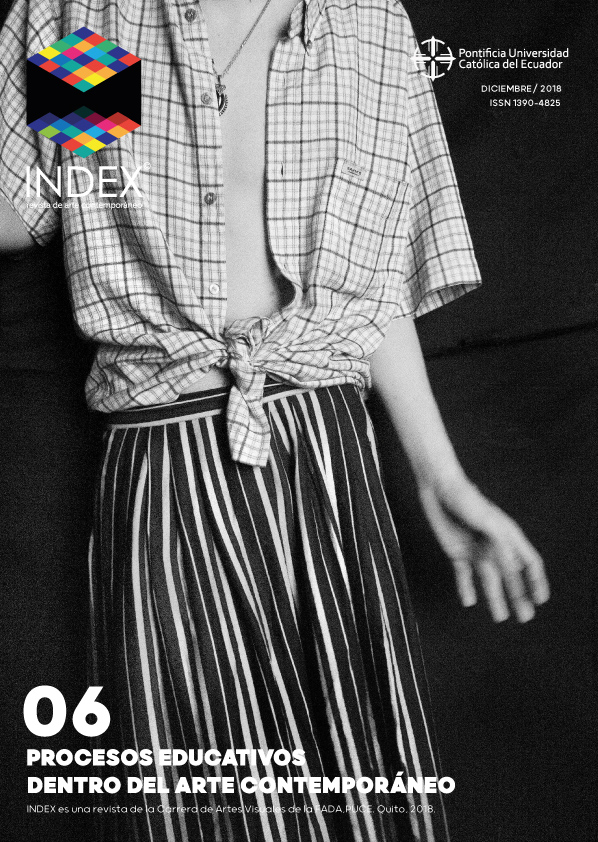ANIMALES: INTÉRPRETES INCONSCIENTES EN EL ARTE INTERACTIVO unwitting performers in interactive art
Contenido principal del artículo
Resumen
Algunos investigadores han categorizado los roles de los personajes dentro del performance artístico interactivo (Reeves, 2008; Sheridan, BryanKinns & Bayliss, 2007), sin embargo, no queda claro las relaciones que emergen de la presencia de animales intérpretes (Cull, 2015) en la obra interactiva. En este artículo se estudiarán la presencia de animales en el performance interactivo y sus efectos sobre la audiencia, para lo cual se han identificado tres aproximaciones: (Benford, et.al., 2013) (i) una revisión de la literatura de los roles dentro del performance interactivo; (ii) la revisión de la obra Snail´s Place, que presenta caracoles como generadores de indeterminabilidad en el sistema computacional; (iii) y, a través de un estudio centrado en el humano sobre la relación animal-computadora-audiencia. Finalmente, se identifica y describe a intérpretes inconscientes capaces de transformar la obra y la audiencia (Orozco, 2015).
Descargas
Detalles del artículo
Index, revista de arte contemporáneo maneja sus derechos bajo licencia Creative Commons Reconocimiento-NoComercial 4.0. En ese sentido los envíos quedan sujetos a la decisión del autor.
Citas
Benford, S., Crabtree, A., Flintham, M., Greenhalgh, C., Koleva, B., Adams, M., Tandavanitj, N., Row Farr, J., Giannachi, G., & Lindt, I. (2011). Creating the Spectacle: Designing Interactional Trajectories through Spectator Interfaces. ACM Transactions on Computer-Human Interaction, 18(3), 128. doi:10.1145/1993060.1993061
Benford, S., Greenhalgh, C., Crabtree, A., Flintham, M., Walker, B., Marshall, J., Koleva, B., Egglestone S. R., Giannachi, G., Adams, M., Tandavanitj, N. & Row Farr, J., (2013). PerformanceLed Research in the Wild. ACM Transactions on Computer-Human Interaction, 20(3), 122. doi:10.1145/2491500.2491502
Costello, B., Muller, L., Amitani, S. & Edmonds, E. (2005). Understanding the Experience of Interactive Art: Lamascope in Beta_space, Proceedings of the second Australian conference on Interactive entertainment, 49-56.
Cull, L. (2015) From Homo Performans to Interspecies Collaboration, Expanding the Concept of Performance to Include Animals. In L. Orozco & J. Parker-Starbuck (Eds.), Performing Animality, Animals in Performance Practices (pp. 19-36) Hampshire: Palgrave Macmillan. doi:10.1057/9781137373137.0007
Dixon, S. (2007). Digital Performance, A History of New Media in Theater, Dance, Performance Art, and Installation. Cambridge: MIT Press. doi:10.1162/leon.2008.41.3.294
Gaver, W., Beaver, J. & Benford, S. (2004). Ambiguity as a Resource for Design, CHI"™03 Proceedings of the SIGCHI Conference on Human Factors in Computing Systems, 5(1), 233-240. doi:10.1145/642611.642653
Goldberg, K. (n.d.) In Berkeley, University of California. Recuperado Marzo 22, 2018, de http://goldberg.berkeley.edu/garden/Ars/
GrosseHering, B.,Mason, J., Aliankseyeu, D., Bakker. C. & Desmet, P. (2013). Slow Design for Meaningful Interactions, CHI 2013: Changing Perspectives, 34313440. doi:10.1145/2470654.2466472
Heitlinger, S. & BryanKinns, N. (2016). Understanding performative behaviour within content rich Digital Live Art, Digital Creativity, 24(2), 111-118. doi:10.1080/14626268.2013.808962
Jochum, E. & Goldberg, K. (2016). Cultivating the Uncanny: The Telegarden and Other Oddities. In D. Herath, C. Kroos & Stelarc (Eds.), Robots and Art, Exploring an Unlikely Symbiosis, (pp. 149-175) Singapore: Springer. doi:10.1007/978-981-10-0321-9_8
Koleva, B. & Schnädelbach, H. (2016).Traversable interfaces between real and virtual worlds, Proceedings of the SIGCHI conference on Human Factors in Computing Systems, 233-240. doi:10.1145/332040.332437
Lieser W. (2009). Digital Art, Konigswinter: H.F. Ullmann.
Marsh T. (2015). Designing for Positive and Serious Experience: Devices for Creativity, Engagement, Reflection and Learning, Joint International Conference on Serious Games, 3-10. doi.org/10.1007/978-3-319-19126-3_1
Orozco, L (2015). There and not There, Looking Animals in Contemporary Theatre. In L. Orozco & J. Parker-Starbuck (Eds.), Performing Animality, Animals in Performance Practices (pp. 189-203) Hampshire: Palgrave Macmillan. doi:10.1057/9781137373137_11
Pearson, M. (2006). "˜In Comes I"™ Performance, Memory and Landscape. Exeter: University of Exeter Press.
Pearson, M. & Thomas, J. (1994). Theatre/Archaeology, TDR (1988) 38(4), 133-161. doi:10.2307/1146429
Purcell, M. (2002). Excavating Lefebvre: The right to the city and its urban politics of the inhabitant. GeoJournal 58(2), 99-108. doi:0.1023/B:GEJO.0000010829.62237.8f
Preece, J., Rogers, I., & Sharp, H. (2002). Interaction Design: Beyond Human-Computer Interaction. New York: John Wiley & Sons.
Reeves, S. (2008). Designing Interfaces in Public Settings, Understanding the Role of the Spectator in Human-Computer Interaction. London: Springer. doi:10.1007/978-0-85729-265-0
Sheridan, J., BryanKinns, N. & Bayliss, A. (2007). Encouraging Witting Participation and Performance in Digital Live Art, BCSHCI '07 Proceedings of the 21st British HCI Group Annual Conference on People and Computers: HCI...but not as we know it. (1), 13-23.
Vickyisley (2008, June 20) Real Snail Mail will officially launch at SIGGRAPH 2008. Recuperado de https://realsnailmail.wordpress.com/2008/06/

